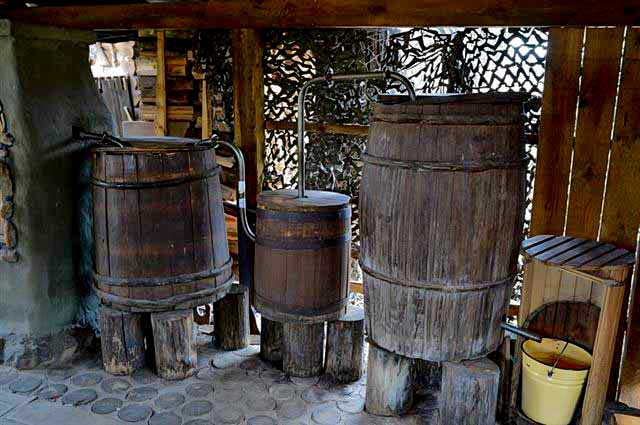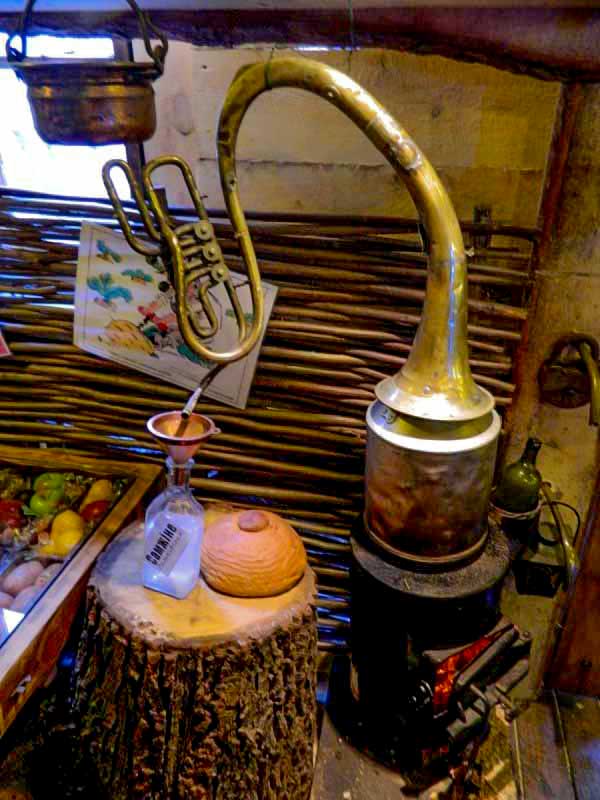The Transcarpathian variety of Ukrainian moonshine was called palenka. Until the 1860s, the main principle of moonshiners in Transcarpathia, as well as in the whole of Western Ukraine, was to drive very slowly, attracting up to 45% of the volume of raw materials used for distillation. The principle “let it be less, but better” in moonshine was a common practice not only in the case of the first stage, when ordinary moonshine was produced, but also for the second and third. All this led to significant losses of raw materials and was possible only in the conditions of non-commodity production that existed in Transcarpathia before the abolition of serfdom in 1853.
The distiller was hardly worried about the profitability of his business-his main concern was the quality of the drink, to achieve which he spared neither raw materials nor time.
So, for example, from 28 liters of Braga received only 1 liter of simple, but “good” moonshine, which when recycled and diluted gave 0.55 liters of high-quality palenki.
In General, the process of making high-quality Transcarpathian palenki is quite complex. The variety of chemical components that are used at all stages of palenki production, from the selection of primary raw materials to the distillation and purification of the finished strong drink, required a careful approach and strict compliance with all technologies. Due to the fact that for a long period of time, the literature on “distillation“it was banned because it did not correspond to the ideals of the “socialist way of life”, and many recipes for cooking zhzhenka were irrevocably lost and forgotten. For moonshine in Transcarpathia, potatoes, plums, apricots, cherry plums, pears, currants, mulberries, sugar and honey were used.
Under the rule of Brezhnev, moonshine was driven even from sweets – “pads”, “peas”.
But the most “useful” and good” palenka ” from birch juice. For enameled thirty-liter juice boiling, 300 grams of yeast and 2-3 kilograms of sugar were taken.
Moonshine machines in Transcarpathia were noted for their great ingenuity. The memories of older people about such amazing inventions are still preserved.
A little about Subcarpathian cuisine

In their time, inventive Transcarpathian peasants made moonshine machines from a boot, with musical instrument – pipes, even from an airplane turbine, from an ordinary kettle and trough. Moonshine machines were made of different materials. Modern moonshine machines German orRomanian production is made exclusively of copper. Our people made of what they had at hand. In the villages of Transcarpathia in ancient times, most farmers used moonshine, which was made from a wooden trough for pigs. During the cooking process, water was constantly added to it to cool it down. In addition, in the villages there were also large-sized devices, they were assembled from copper cauldrons, in them, in Carpathian, in ancient times, milk was boiled to produce cheese.
It should also be noted that in Transcarpathia it is driven mainly, not aggressive and intoxicating “cuccu” or “cartablanca”, which leads to an extremely heavy and aggressive ohmna and fragrant fruity plum, chereshnivka, the Perry baracco (with apricot).
One of the most popular alcoholic beverages in Transcarpathia was slivovitsa. For its preparation, special varieties of plums were used, and the fruit was not torn from the branches, but shaken. After all, only the bravest of them will fall out of the tree. The plums, along with the seeds, had to be ground in a large container, gradually adding water, until a mushy mass was obtained. Then the porridge was placed in a barrel, and when, about a week later, it stopped hissing and foaming, you could brew moonshine. The strength of this drink reached 45%. Another option is double-distilled slivovitsa, whose strength is already 75%. The aging time of slivovitsa was different. Old-timers claim that in order to taste a truly divine drink, you need to wait for five years, keeping it in the oak barrels. Then palenka will get a deeper and richer plum flavor and its own noble yellow color. The temperature of this fruit drink can be any: at room temperature, slightly chilled, or at Czech manners, slightly warmed up and even quite hot.








